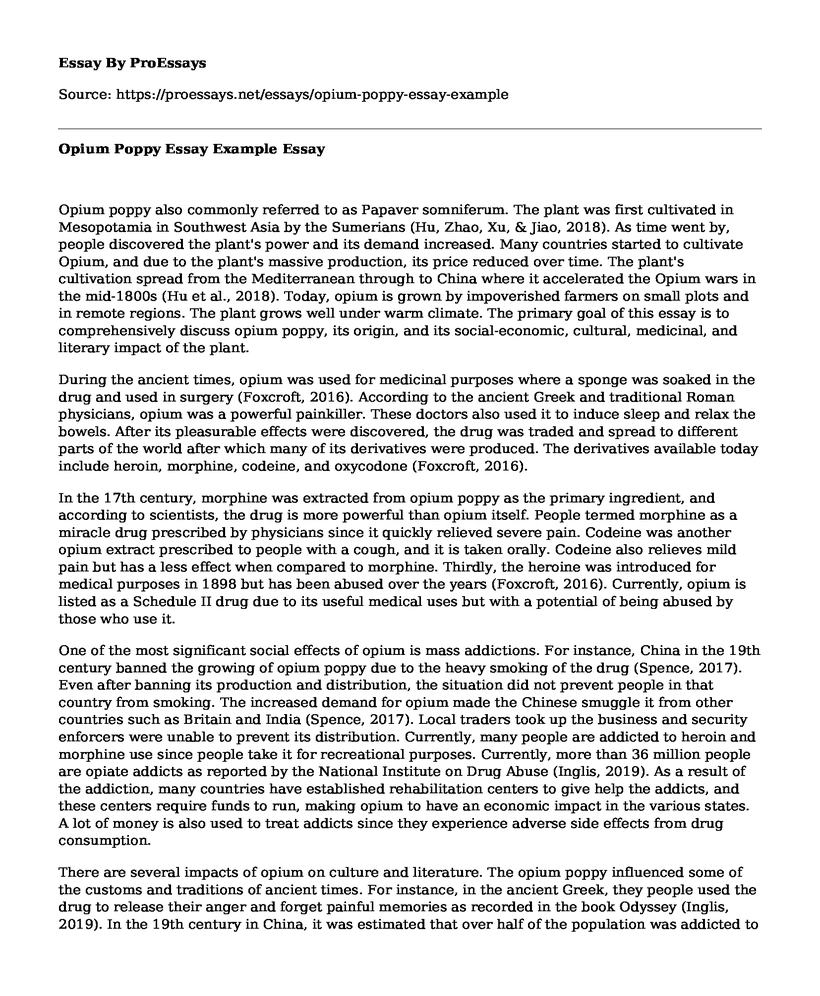Opium poppy also commonly referred to as Papaver somniferum. The plant was first cultivated in Mesopotamia in Southwest Asia by the Sumerians (Hu, Zhao, Xu, & Jiao, 2018). As time went by, people discovered the plant's power and its demand increased. Many countries started to cultivate Opium, and due to the plant's massive production, its price reduced over time. The plant's cultivation spread from the Mediterranean through to China where it accelerated the Opium wars in the mid-1800s (Hu et al., 2018). Today, opium is grown by impoverished farmers on small plots and in remote regions. The plant grows well under warm climate. The primary goal of this essay is to comprehensively discuss opium poppy, its origin, and its social-economic, cultural, medicinal, and literary impact of the plant.
During the ancient times, opium was used for medicinal purposes where a sponge was soaked in the drug and used in surgery (Foxcroft, 2016). According to the ancient Greek and traditional Roman physicians, opium was a powerful painkiller. These doctors also used it to induce sleep and relax the bowels. After its pleasurable effects were discovered, the drug was traded and spread to different parts of the world after which many of its derivatives were produced. The derivatives available today include heroin, morphine, codeine, and oxycodone (Foxcroft, 2016).
In the 17th century, morphine was extracted from opium poppy as the primary ingredient, and according to scientists, the drug is more powerful than opium itself. People termed morphine as a miracle drug prescribed by physicians since it quickly relieved severe pain. Codeine was another opium extract prescribed to people with a cough, and it is taken orally. Codeine also relieves mild pain but has a less effect when compared to morphine. Thirdly, the heroine was introduced for medical purposes in 1898 but has been abused over the years (Foxcroft, 2016). Currently, opium is listed as a Schedule II drug due to its useful medical uses but with a potential of being abused by those who use it.
One of the most significant social effects of opium is mass addictions. For instance, China in the 19th century banned the growing of opium poppy due to the heavy smoking of the drug (Spence, 2017). Even after banning its production and distribution, the situation did not prevent people in that country from smoking. The increased demand for opium made the Chinese smuggle it from other countries such as Britain and India (Spence, 2017). Local traders took up the business and security enforcers were unable to prevent its distribution. Currently, many people are addicted to heroin and morphine use since people take it for recreational purposes. Currently, more than 36 million people are opiate addicts as reported by the National Institute on Drug Abuse (Inglis, 2019). As a result of the addiction, many countries have established rehabilitation centers to give help the addicts, and these centers require funds to run, making opium to have an economic impact in the various states. A lot of money is also used to treat addicts since they experience adverse side effects from drug consumption.
There are several impacts of opium on culture and literature. The opium poppy influenced some of the customs and traditions of ancient times. For instance, in the ancient Greek, they people used the drug to release their anger and forget painful memories as recorded in the book Odyssey (Inglis, 2019). In the 19th century in China, it was estimated that over half of the population was addicted to opium (Spence, 2017). Initially, smoking was a fun and social activity until later when it became addictive. Until today, many people still use opium for recreational purposes and therefore its impact on culture. Literary effects of opium include its use in Romantic poetry where many authors critic the influence of the drug.
Conclusion
In conclusion, opium was initially intended to reduce severe pain and for other medical purposes but with time, people started abusing it. The various forms of opium poppy include heroin, morphine, codeine, and oxycodone. One of the medical impacts of the substance is that it was used as anesthesia to prevent pain during surgery. Codeine was used to suppress a cough. One of the social effects of opium poppy is addiction especially in China where more than half of the men in that country are chain smokers. Such habits have an economic impact in any state since finances are required to treat and rehabilitate users. Some of the ancient traditions were also influenced by the drug where people smoked or mixed it with wine for recreational purposes.
References
Foxcroft, L. (2016). The making of addiction: the'use and abuse'of opium in nineteenth-century Britain. Routledge.
Hu, Y., Zhao, R., Xu, P., & Jiao, Y. (2018). The Genome of Opium Poppy Reveals Evolutionary History of Morphinan Pathway. Genetics, 1672, 0229.
Inglis, L. (2019). Milk of Paradise: A History of Opium. Pegasus Books.
Spence, J. (2017). Opium smoking in Ch'ing China. In European Intruders and Changes in Behaviour and Customs in Africa, America and Asia before 1800 (pp. 315-345). Routledge.
Cite this page
Opium Poppy Essay Example. (2022, Nov 20). Retrieved from https://proessays.net/essays/opium-poppy-essay-example
If you are the original author of this essay and no longer wish to have it published on the ProEssays website, please click below to request its removal:
- Root Causes of Crimes in Low-Income, "Inner-City" Neighborhoods - Essay Sample
- Article Analysis Essay on "The Syrian Humanitarian Disaster" and "A Crisis of Anxiety Among Aid Workers"
- Research Paper on Violence in Schools: Physical, Psychological and Sexual Harms
- Walgreens: Transatlantic Cancer Prevention & Support Partnership - Essay Sample
- Closing the Gender Leadership Gap: How Stereotypes Affect Women Leaders - Essay Sample
- My Interview with an Experienced Nurse Practitioner: Essay Sample
- Ensuring Quality Patient Care & Safety in Health Organizations - Essay Sample







